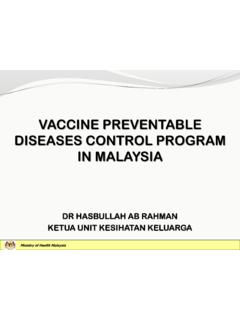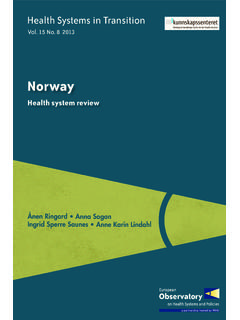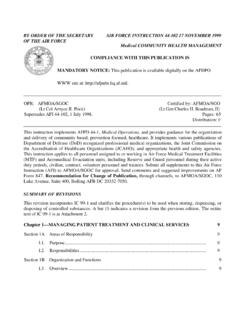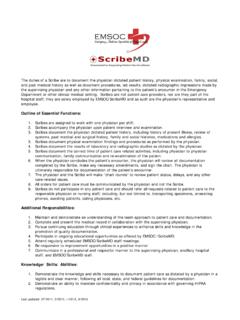Transcription of Dr Nor Azni Yahaya - Jabatan Kesihatan Negeri Kelantan
1 dr nor azni Yahaya Acute flaccid paralysis (AFP) is a clinical syndrome characterized by rapid onset of weakness, including (less frequently) weakness of the muscles of respiration and swallowing, progressing to maximum severity within several days to weeks. The term "flaccid" indicates the absence of spasticity or other signs of disordered central nervous system motor tracts such as hyperreflexia, clonus, or extensor plantar responses AFP is a complex clinical syndrome with a broad array of potential etiologies. Accurate diagnosis of the cause of AFP has profound implications for therapy and prognosis. If untreated, AFP may not only persist but also lead to death due to failure of respiratory muscles. AFP, a syndrome that encompasses all cases of paralytic poliomyelitis, also is of great public health importance because of its use in surveillance for poliomyelitis in the context of the global polio eradication initiative.
2 Each case of AFP is a clinical emergency and requires immediate examination. For all cases, a detailed clinical description of the symptoms should be obtained, including fever, myalgia, distribution, timing, and progression of paralysis. The symptoms of paralysis may include gait disturbance, weakness, or troubled coordination in one or several extremities Comprehensive neurologic examination, including assessment of muscle strength and tone, deep tendon reflexes, cranial nerve function, and sensation Look for meningismus, ataxia, or autonomic nervous system abnormalities (bowel and bladder dysfunction, sphincter tonus, neurogenic reflex bladder) Fasciculation is often cited as a sign of anterior horn cell damage, but it may also be present in demyelinating neuropathies. Electrophysiologic studies are very important for determining the diagnosis and prognosis of lower motor neuron disease Nerve conduction velocity and electromyographic studies are used to differentiate demyelinating neuropathies from axonal neuropathies Clinical Pathways for AFP Guillain-Barre syndrome.
3 The commonest cause of acute flaccid paralysis (AFP) in healthy children per 100,000 population <15y Acute inflammatory demyelinating polyradiculoneuropathy (AIDP) Symmetrical progressive ascending weakness, areflexia, variable sensory complaints, and elevated CSF protein without pleocytosis Acquired, monophasic Immune mediated disease No known genetic factor Two thirds of cases follow a respiratory or gastrointestinal infection Campylobacter infection is the most common, but other organisms include CMV, EBV, HSV, enteroviruses, .. The main lesions are acute inflammatory demyelinating polyradiculoneuropathy, with acute axonal degeneration in some cases, particularly those following campylobacter infection A variety of autoantibodies to gangliosides have been identified especially with axonal forms of the disease Two to four weeks after a benign febrile illness Common presentations are paresthesias in the fingers and toes, pain is a common presentation in children (79%)
4 , particularly low back pain Symmetrical weakness in the lower extremities, that ascends over hours to days to involve the arms, and in severe cases respiratory muscles Cranial nerves are affected in 30% of the cases, most commonly the facial nerve with bilateral facial weakness More than 90% of patients reach the nadir of their function within 2-4 weeks Symmetrical weakness with diminished or absent reflexes Vibration and position sensation are affected in 40% of cases 50% of patients have evidence of autonomic dysfunction Cardiac dysrythmias Orthostatic hypotension, hypertension Paralytic ileus Bladder dysfunction Cerebrospinal fluid: After the first week of symptoms, CSF typically reveals normal pressure, normal cell count, and elevated protein Electrophysiologic studies.
5 Most specific and sensitive tests for diagnosis Evidence of evolving multifocal demyelination Normal studies after 10 days of illness make the diagnosis of GBS unlikely Expectant with mild cases Immune modulatory therapy for rapidly progressive cases, most effective the first 10 days Plasmapharesis IVIG Steroids are not effective and not indicated Critical care monitoring Most common cause of death is autonomic dysfunction Second most common cause of death is respirotory failure Risk factors for respiratory failure in GBS Cranial nerve involvement Short time from preceding respiratory illness Rapid progression over less than 7 days Elevated CSF protein in the first week Severe weakness Unable to lift elbows above the bed Unable to lift head above the bed Unable to stand Children have a shorter clinical course than adults Severity of the illness does not correlate with long term outcome, 85% of children have excellent recovery 50% are ambulatory by 6 months.
6 70% walk within a year of onset of the disease Acute demyelinating disorder of the spinal cord that evolves over days usually but may have a hyperacute presentation May be associated with demyelination in other parts of the central nervous system Commonly preceded by a viral infection or immunization Commonly presents with an ascending weakness Initially reflexes may be depressed or absent because of spinal shock or involvement of the nerve roots Must be considered in cases of weakness without bulbar involvement Mean age of onset is 9 years Symptoms progress rapidly, peaking within 2 days Usually level of myelitis is thoracic Sensory level, asymmetrical leg weakness, and early bladder involvement. Back pain is common at the onset Tendon reflexes may be decreased or increased Recovery usually begins after a week of onset Diagnosis: MRI of the spine usually shows swelling of the cord, but at times is normal.
7 Exclusion of acute cord compression is essential High doses of IV steroids (methylprednisolone) followed by tapering doses of prednisone Prognosis: 50% make a full recovery, 40% recover incompletely, and 10% do not recover Poliovirus, cosxackievirus, and the echovirus group are RNA viruses that inhabit the GI tract of humans They are neurotropic, and produce paralytic disease by destroying the motor neurons of the brainstem and spinal cord Poliovirus causes the most severe paralysis, coxsackie and echoviruses are more likely to cause an aseptic meningitis Nonpolio enteroviruses hav been associated with polio-like paralytic disease, frequently accompanied by other clinical syndromes, such as aseptic meningitis, hand-foot-and-mouth disease, and acute hemorrhagic conjunctivitis.
8 Among all known nonpolio enteroviruses, enterovirus 71 has been most strongly implicated in outbreaks of central nervous system disease and AFP. Known since ancient Egyptian times English physician Michael Underwood in 1789, refers to polio as "a debility of the lower extremities Poor sanitation contributed to increased natural immunities among human population Outbreaks started to occur in 20th century Outbreaks reached pandemic proportions in Europe, North America, Australia, and New Zealand during the first half of the 20th century. In US, 1952 polio epidemic became the worst outbreak in the nation's history. Of nearly 58,000 cases reported that year 3,145 died and 21,269 were left with mild to disabling paralysis. Intensive care medicine has its origin in the fight against polio Epidemics usually occur in the spring and summer Usually a brief illness characterized by fever, malaise and GI symptoms precedes the paralytic illness After the febrile illness, there is a brief period of apparent well being, after which the fever recurs, with headache, vomiting and meningeal irritation Pain in the limbs and spine is followed rapidly by limb weakness Pattern of limb weakness is variable, but is generally asymmetric Weakness.
9 Diminished reflexes and muscle atrophy are seen Paralysis Bulbar polio may occur with or without spinal polio and is life threatening Affected children have prolonged periods of apnea and require mechanical ventilation Extraoccular muscles are spared Paralytic polio is rarely seen after the introduction of the polio vaccine Diagnosis: Clinical suspicion CSF leukocytosis is seen the acute phase, elevated protein may also be seen CBC shows leukocytosis Virus recovery from stool is essential Obtain stool, blood and throat samples for viral serology, demonstrating a four fold rise in IgG is helpful but not always easy. Positive IgM antibodies is diagnostic Treatment: mainly supportive Mechanical ventilation may be needed in bulbar involvement Pain management for paresthesias Physical therapy The early 20th century epidemics which left thousands of children and adults paralyzed provided the impetus for a "Great Race" towards the development of a vaccine.
10 Developed in the 1950s, polio vaccines are credited with reducing the global number of polio cases per year from many hundreds of thousands to around a thousand 1950 Koprowsky intoduced live attenuated vaccine 1952 Salk developed The Salk vaccine, or inactivated poliovirus vaccine (IPV), based on poliovirus grown in a type of monkey kidney tissue culture(Vero cell line), which is chemically inactivated with formalin. After two doses of IPV (given by injection), 90% or more of individuals develop protective antibody to all three serotypes of poliovirus, and at least 99% are immune to poliovirus following three doses Albert Sabin developed oral polio vaccine (OPV The attenuated poliovirus in the Sabin vaccine replicates very efficiently in the gut, but the vaccine strain is unable to replicate efficiently within nervous system tissue.)








